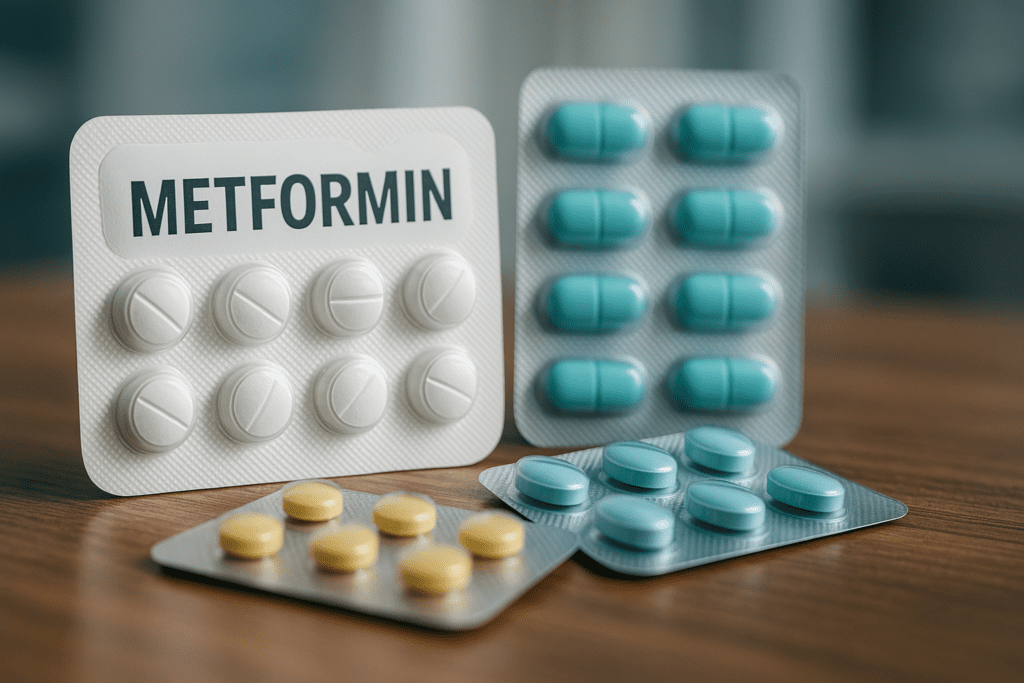Introduction: Rethinking the Role of Metformin in Modern Diabetes Care
For decades, metformin has stood at the forefront of oral diabetic drugs, frequently prescribed as the first-line therapy for managing type 2 diabetes. Its reputation as a cost-effective, well-researched, and generally safe medication has made it a staple in diabetes care worldwide. However, not every patient tolerates metformin well. Gastrointestinal side effects, kidney function concerns, and long-term use implications have prompted both patients and clinicians to ask an increasingly common question: what can I take instead of metformin? As research into diabetes medications rapidly evolves, safer and more effective options are emerging—both as replacements and adjuncts.
You may also like: Breakthroughs in Current Diabetes Research: What the Latest Studies Reveal About Treatment and Prevention
This article delves deeply into the landscape of alternative medication to metformin, highlighting promising jardiance alternatives, new oral diabetic drugs, and the broader question of what medications treat type II diabetes mechanism of action. We explore the clinical rationale behind choosing a metformin substitute, examine what the latest studies suggest about drug efficacy and safety, and consider when over the counter diabetes medication may be appropriate. For patients asking what to take instead of metformin for prediabetes or those seeking a metformin replacement for long-term management, this guide offers expert-level insight backed by current research.
Why Some Patients Need a Metformin Substitute
While metformin is widely effective and inexpensive, it is not universally well-tolerated. Some individuals experience gastrointestinal side effects like nausea, bloating, and diarrhea, which can interfere with daily life and adherence. Others face more serious contraindications, such as impaired kidney function, which limits metformin use due to the risk of lactic acidosis. There are also patients who simply prefer to avoid prescription medications if possible and instead look for non prescription diabetes medication options.
Beyond side effects, there is increasing awareness that metformin is not a one-size-fits-all solution. Personalized medicine is guiding diabetes care toward therapies that better match an individual’s specific risk profile, comorbidities, and metabolic characteristics. For instance, someone with established cardiovascular disease may benefit from a class of diabetes medications that reduces heart failure risk, while a person with obesity might respond better to medications that promote weight loss. In all these cases, an alternative to metformin may offer a more tailored and effective therapeutic approach.

Understanding the Classes of Diabetes Medications
Before diving into specific metformin alternatives, it helps to understand the broader landscape of diabetic drugs. So how many classes of diabetes medications are there? Currently, there are more than ten, each with distinct mechanisms of action. These include biguanides (like metformin), sulfonylureas, thiazolidinediones (TZDs), DPP-4 inhibitors, GLP-1 receptor agonists, SGLT2 inhibitors, alpha-glucosidase inhibitors, meglitinides, bile acid sequestrants, dopamine-2 agonists, and insulin therapies.
Each class interacts with glucose metabolism in unique ways. For example, SGLT2 inhibitors promote glucose excretion through the urine, while GLP-1 receptor agonists stimulate insulin release and suppress appetite. Understanding what medications treat type II diabetes mechanism of action allows clinicians to combine drugs more effectively and target multiple pathways. This comprehensive strategy can help reduce hemoglobin A1C levels more reliably, address comorbidities, and minimize adverse effects.
New Oral Diabetic Drugs That Work Like Metformin But Safer
As pharmaceutical research progresses, newer oral diabetic drugs have emerged that mimic some of metformin’s beneficial effects—with fewer drawbacks for certain patients. Among the most notable are SGLT2 inhibitors and DPP-4 inhibitors. These classes not only help control blood glucose but also offer additional health benefits, particularly for patients with cardiovascular or kidney disease.
Drugs like empagliflozin and dapagliflozin, both SGLT2 inhibitors, have demonstrated reduced risks of heart failure hospitalization and slowed kidney disease progression. This makes them compelling jardiance alternatives, especially in patients seeking a metformin substitute with cardioprotective effects. While these medications are not universally safer, they may be preferable for those with metformin intolerance or contraindications. Additionally, DPP-4 inhibitors such as sitagliptin provide a weight-neutral option that does not usually cause hypoglycemia, making them a useful metformin alternative in older adults or those with frailty.
What Is the Best Medicine to Lower A1C Besides Metformin?
Determining what is the best medicine to lower A1C depends on the patient’s overall health status, treatment goals, and risk factors. GLP-1 receptor agonists such as semaglutide and liraglutide have been shown to achieve significant reductions in A1C, sometimes exceeding those seen with metformin. These injectable medications also offer robust weight loss benefits and have been linked to cardiovascular event reduction in clinical trials.
While not an oral medication, the efficacy of GLP-1 receptor agonists in lowering A1C makes them a powerful alternative medicine for metformin in patients who qualify for injectable therapy. Their growing popularity among endocrinologists stems from their ability to target multiple aspects of metabolic health simultaneously. However, cost and route of administration may be limiting factors for some.
Over the Counter Diabetes Medication and Nonprescription Options
For individuals who either cannot take prescription medications or prefer a more natural approach, the question often arises: is there an alternative to metformin available over the counter? While no OTC diabetes medication matches the clinical potency of prescription drugs, certain supplements may offer modest benefits. Common over the counter diabetes medication options include alpha-lipoic acid, berberine, and cinnamon extract, which have shown limited efficacy in small trials or animal models.
It’s important to stress that OTC diabetes meds are not regulated with the same rigor as prescription medications. Therefore, patients exploring non prescription diabetes medication should consult with a healthcare provider before starting any supplement. Still, for those seeking a gentle intervention or support for prediabetes, some sugar tablets for diabetes management and natural therapies may offer incremental support. When used alongside lifestyle changes, these options can serve as complementary strategies.

What Other Drugs Are Necessary When Taking Insulin?
Many patients with advanced type 2 diabetes eventually require insulin, but insulin alone may not always provide comprehensive control. This raises an important clinical question: what other drugs are necessary when taking insulin? In practice, combining insulin with other classes of diabetes medications can enhance glycemic stability, reduce required insulin doses, and mitigate side effects such as weight gain.
For instance, pairing insulin with an SGLT2 inhibitor or GLP-1 receptor agonist may help blunt postprandial glucose spikes and support cardiovascular health. Similarly, DPP-4 inhibitors are sometimes used alongside basal insulin for patients who need fine-tuned glucose control without hypoglycemia risk. These strategies highlight the importance of individualizing therapy and demonstrate that even insulin-dependent patients may benefit from an alternative medication to metformin.
Considering Side Effects of Antidiabetic Drugs in Medication Selection
All medications carry risk, and the side effects of antidiabetic drugs must be weighed carefully against their benefits. Metformin, despite its reputation for safety, is not exempt from concerns. Long-term use may reduce vitamin B12 absorption, and gastrointestinal upset remains a common complaint. By comparison, sulfonylureas increase hypoglycemia risk, TZDs can promote weight gain and edema, and GLP-1 receptor agonists may cause nausea or vomiting.
In the pursuit of alternatives that work like metformin but safer, attention has turned to drugs with fewer metabolic consequences. SGLT2 inhibitors, for example, pose a low risk of hypoglycemia but carry risks of urinary tract infections and rare ketoacidosis. The decision of what medication is used for diabetes must therefore account for both patient preference and clinical context. A thoughtful balance of efficacy, safety, and convenience is essential.
Top-Ranked Options: What Are the Top 10 Diabetes Medications Today?
Patients and providers often ask: what are the top 10 diabetes medications currently available? While rankings can vary by individual needs, current clinical guidelines frequently recommend the following as frontline or adjunct therapies: metformin, empagliflozin, semaglutide, liraglutide, sitagliptin, glipizide, pioglitazone, dulaglutide, canagliflozin, and linagliptin. These medications represent a mix of oral diabetic drugs and injectable agents with diverse mechanisms of action.
Among these, several serve as effective replacements for metformin or as supplements when metformin alone is insufficient. Patients looking for an alternative for tradjenta (linagliptin) may also find these rankings useful, especially when navigating insurance coverage or evaluating side effect profiles. Understanding what is the best diabetic medicine for a given individual often requires input from a healthcare team, along with patient-centered goals and lifestyle factors.
Alternative Medicine for Metformin in Prediabetes Management
Metformin is sometimes prescribed off-label for prediabetes, particularly in individuals with insulin resistance and high cardiovascular risk. However, some patients may prefer to avoid pharmaceuticals during this early stage and instead seek an alternative medicine for metformin. In such cases, lifestyle interventions remain the gold standard. Weight loss, physical activity, and dietary modification consistently outperform pharmacological agents in delaying diabetes progression.
Still, those asking what can I take instead of metformin for prediabetes may benefit from supplements such as berberine, inositol, or chromium. These agents have shown promise in improving insulin sensitivity in small studies, though larger trials are needed. When combined with structured lifestyle coaching, these strategies can form the backbone of an early, proactive approach to metabolic health without immediate reliance on pharmaceuticals.
What Symptom May Antidiabetic Medications Relieve Beyond Blood Sugar Control?
One under-discussed topic is the non-glycemic benefits of diabetes therapies. So what symptom may antidiabetic medications relieve besides high blood sugar? Depending on the drug class, patients may experience improved blood pressure, reduced appetite, better lipid profiles, or even reduced inflammatory markers. GLP-1 receptor agonists, in particular, have been associated with weight loss, appetite suppression, and improved satiety.
Meanwhile, SGLT2 inhibitors have demonstrated benefits in reducing fluid overload and lowering systolic blood pressure, making them useful in heart failure patients. Recognizing these secondary effects allows clinicians to choose therapies that align with a patient’s broader health needs. These additional benefits may influence the decision for a metformin replacement, especially when treating complex or comorbid conditions.

Frequently Asked Questions: Metformin Alternatives and Modern Diabetes Treatments
1. What are some practical reasons a patient might prefer a metformin substitute over traditional therapy?
Beyond gastrointestinal intolerance and kidney concerns, some patients prefer a metformin substitute due to personal values, lifestyle priorities, or long-term treatment goals. For example, individuals pursuing fertility treatments may seek alternatives to metformin because of its potential impact on ovulation patterns or hormonal profiles. Athletes and active individuals often explore options that minimize gastrointestinal disruption, which can interfere with training. In addition, some patients with gastrointestinal conditions like IBS may experience symptom flare-ups with metformin and opt for oral diabetic drugs with more targeted absorption profiles. The desire for newer drugs that work like metformin but safer, especially in those with complex medical histories, continues to drive the development of novel therapies.
2. How do jardiance alternatives compare in terms of cardiovascular benefits and kidney protection?
Jardiance (empagliflozin) has become a standout in the field of diabetes medications due to its documented heart and kidney benefits. However, other SGLT2 inhibitors like canagliflozin and dapagliflozin are strong jardiance alternatives, offering similar protection against heart failure and chronic kidney disease progression. Recent trials suggest these alternatives can reduce hospitalizations and mortality, especially when paired with insulin or GLP-1 receptor agonists. Patients with established cardiovascular conditions or moderate renal impairment may find these agents preferable to older medications. As research deepens, many of these drugs are becoming foundational in treatment protocols beyond just glucose control, helping clinicians rethink what medications treat type II diabetes mechanism of action holistically.
3. Are there meaningful differences among the top 10 diabetes medications in terms of weight management?
Yes, and these differences often inform the choice of treatment. Among the top 10 diabetes medications, GLP-1 receptor agonists such as semaglutide and liraglutide stand out for their dual role in lowering A1C and promoting weight loss. In contrast, sulfonylureas and thiazolidinediones may lead to weight gain, making them less appealing for patients with obesity. SGLT2 inhibitors provide modest weight reduction through urinary glucose excretion, offering another weight-conscious option. When evaluating what is the best diabetic medicine for someone with concurrent metabolic syndrome, weight impact becomes a critical consideration. The varied effects among these medications offer a personalized toolkit for managing both diabetes and related conditions.
4. What should patients consider when exploring an alternative for tradjenta (linagliptin)?
Patients seeking an alternative for tradjenta typically want to maintain DPP-4 inhibitor benefits while improving cost, access, or tolerability. Sitagliptin and saxagliptin are common replacements, with similar glucose-lowering effects and safety profiles. However, newer research points toward broader benefits from combining DPP-4 inhibitors with other classes, especially in elderly patients or those with mild renal impairment. When choosing an alternative medication to metformin that still fits the DPP-4 class, patients should consider renal dosing requirements, drug interactions, and whether they need combination pills for adherence. It’s also important to explore if newer options within other classes might offer added protection against long-term complications.
5. Can otc diabetes medication be effective for managing prediabetes or mild glucose elevations?
Over the counter diabetes medication may offer mild benefits for blood sugar regulation in the early stages of insulin resistance. Ingredients like berberine, chromium, and alpha-lipoic acid have been studied for their ability to improve insulin sensitivity and reduce post-meal glucose spikes. While these options do not replace prescription medications, they can serve as complementary strategies when combined with diet and exercise. For individuals asking what can I take instead of metformin for prediabetes, these supplements may offer a bridge between lifestyle changes and pharmaceutical intervention. However, it is essential to discuss any non prescription diabetes medication with a healthcare provider to ensure safety, particularly in individuals with complex medical histories or polypharmacy.
6. How do clinicians determine what other drugs are necessary when taking insulin?
When insulin therapy alone is insufficient for optimal control, clinicians evaluate what other drugs are necessary when taking insulin based on the patient’s glucose profile, comorbidities, and tolerance. For instance, if a patient experiences post-meal spikes, adding a GLP-1 receptor agonist can improve outcomes and reduce insulin dose requirements. In contrast, DPP-4 inhibitors might be added for patients at risk of hypoglycemia or those seeking simplified regimens. For patients with heart or kidney issues, combining insulin with SGLT2 inhibitors often offers substantial protection beyond glycemic effects. Choosing the right adjunct therapy requires careful consideration of the individual’s lifestyle, weight goals, and tolerance to side effects of antidiabetic drugs.
7. Are there any promising future developments in oral diabetic drugs that could replace metformin?
Yes, the pipeline for oral diabetic drugs is expanding with exciting innovation. Researchers are developing gut-restricted GLP-1 receptor agonists that mimic the effects of injectables without systemic absorption, which could offer a promising metformin substitute. Additionally, dual GIP/GLP-1 receptor agonists in pill form are under investigation and may surpass current medications in A1C reduction and weight loss. Advances in nanotechnology are also enabling targeted drug delivery systems that minimize gastrointestinal side effects. These developments hold potential for patients seeking a solution that works like metformin but safer, especially those with sensitive digestive systems or multiple medication intolerances. Personalized medicine may soon allow prescribers to match therapies more precisely with genetic and metabolic profiles.
8. How does understanding the mechanism of action influence treatment choices?
Understanding what medications treat type II diabetes mechanism of action helps tailor therapy to the patient’s specific physiology. For example, patients with impaired insulin secretion might benefit more from sulfonylureas or GLP-1 receptor agonists, while those with insulin resistance may respond better to TZDs or metformin. This understanding also informs combination therapy decisions, as pairing drugs with complementary mechanisms—such as SGLT2 inhibitors and DPP-4 inhibitors—can maximize efficacy while reducing side effects. By selecting medications based on mechanism rather than trial-and-error, providers can help patients achieve better control with fewer complications. This approach also supports rational transitions when switching from one class to another, such as finding the best alternative to metformin in patients with renal challenges.
9. What psychological factors influence a patient’s willingness to try alternative medicine for metformin?
Psychological comfort plays a larger role in diabetes management than often recognized. Some patients resist pharmaceutical interventions due to fear of side effects, a desire for “natural” treatments, or cultural beliefs around medication. For these individuals, alternative medicine for metformin—including herbal supplements and functional nutrition therapies—can offer a more acceptable entry point into glycemic management. Building trust and providing evidence-based explanations about how these therapies interact with physiology is crucial. Practitioners must also evaluate patient readiness and beliefs when recommending an over the counter diabetes medication or exploring what to take instead of metformin, especially in culturally diverse populations.
10. How can sugar tablets for diabetes serve roles beyond emergency hypoglycemia management?
Though commonly associated with treating acute hypoglycemia, sugar tablets for diabetes have broader utility. For example, they can be used during structured exercise regimens to prevent drops in blood sugar or during fasting states where glucose dips are anticipated. In patient education, they provide a tangible tool for explaining carbohydrate content and glycemic response. They also serve a role in diabetes self-management training, teaching patients how to respond to early symptoms of hypoglycemia confidently. While they are not considered part of the primary arsenal of diabetes medications, they remain a valuable support tool, especially when paired with oral diabetic drugs or as part of a strategy to prevent overcorrection with food during episodes of low glucose.
Conclusion: Rethinking Diabetes Treatment with Evidence-Based Metformin Alternatives
The evolving field of diabetes treatment offers patients and clinicians an unprecedented array of options. For those asking what to take instead of metformin, the answer is no longer limited to just one or two choices. From SGLT2 inhibitors to GLP-1 receptor agonists, and from OTC diabetes meds to carefully selected supplements, there is now a diverse spectrum of therapies that can be tailored to the individual. Understanding the mechanisms, benefits, and risks of these medications—and recognizing what other drugs are necessary when taking insulin—empowers patients to advocate for informed, evidence-based care.
As research continues to unfold, what is the best alternative to metformin may shift with new discoveries. But for now, the message is clear: patients have choices, and with the right medical guidance, they can find a metformin substitute that fits both their biology and their lifestyle. Whether the goal is to reduce A1C, avoid side effects of antidiabetic drugs, or manage prediabetes with minimal intervention, today’s therapeutic landscape is more versatile and promising than ever before.
type 2 diabetes treatment options, managing blood sugar naturally, insulin resistance solutions, best medications for blood glucose control, drug alternatives for diabetes care, personalized diabetes therapy, natural remedies for insulin resistance, new treatments for diabetes, safe diabetes medications, diabetic medication side effect management, cardiovascular-safe diabetes drugs, renal-friendly diabetes treatments, diabetes and weight management, prescription-free glucose control, hormone regulation in diabetes, advanced diabetes drug classes, integrative diabetes care, future of diabetes pharmacology, evidence-based diabetes strategies, optimizing A1C control
Further Reading:
8 Metformin Alternatives for Type 2 Diabetes: Ozempic, Jardiance, and More
What medication is available for diabetes?
4 Natural Supplements That Are as Powerful as Drugs
Disclaimer
The information contained in this article is provided for general informational purposes only and is not intended to serve as medical, legal, or professional advice. While MedNewsPedia strives to present accurate, up-to-date, and reliable content, no warranty or guarantee, expressed or implied, is made regarding the completeness, accuracy, or adequacy of the information provided. Readers are strongly advised to seek the guidance of a qualified healthcare provider or other relevant professionals before acting on any information contained in this article. MedNewsPedia, its authors, editors, and contributors expressly disclaim any liability for any damages, losses, or consequences arising directly or indirectly from the use, interpretation, or reliance on any information presented herein. The views and opinions expressed in this article are those of the author(s) and do not necessarily reflect the official policies or positions of MedNewsPedia.


